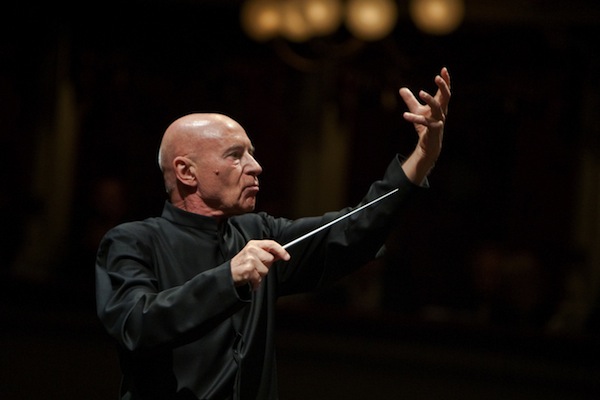Eschenbach makes a triumphant return to Houston Symphony with Bruckner program

Christoph Eschenbach conducted the Houston Symphony Friday night at Jones Hall. File photo: Luca Piva
Former Houston Symphony music director Christoph Eschenbach conducted an all-Bruckner program at Jones Hall Friday night in a joy-filled reunion for conductor and orchestra.
Eschenbach ended his eleven-year tenure eighteen years ago, having raised the Houston Symphony to a high artistic level. During the interim he has served as music director for several major orchestras, including the Philadelphia Orchestra and the National Symphony Orchestra. But it seems that the chemistry he enjoyed with players in Houston has proven elusive elsewhere.
Yet in just a few days of rehearsals, Eschenbach managed to rebuild the past partnership of trust and mutual respect, resulting in a concert that was a highlight of the season.
Bruckner’s Symphony No. 1, first completed in 1866, went through several revisions over 25 years: Eschenbach opted for the 1891, or “Vienna” version.
The symphony is marked by abrupt harmonic and dynamic shifts and short musical motifs that are imitated by various instruments. Extended melodies appear infrequently and are played mostly by the strings. The first movement begins with a march-like theme in the violins that is contrasted and alternated with lyrical themes. The strong influence of Wagner can be heard in a theme and accompaniment reminiscent of Tannhauser.
The Adagio–Andante had the sustained tension and line that was a hallmark of Eschenbach’s tenure as music director. Broad climaxes contrasted with intimate expressive sections. The third movement is a rustic Scherzo with a diabolical undertone. The Trio had a familial and naïve feel that contrasted with the Scherzo. The coda, reinforced by the brass section, provided a rousing ending that continued into the fourth movement.
This finale displayed the monumental expression found in Bruckner’s later symphonies. Changes in tempo were masterfully modulated by Eschenbach, and the symphony ended jubilantly in C-major, with the French horns held high.
From the very first notes and throughout the symphony it was apparent that great attention was given to details of articulation and dynamics. Eschenbach shaped and shaded the orchestral colors according to the music’s harmony and character. He had a clear point of view in each movement with every section of the Houston Symphony presenting inspired orchestral playing worthy of any stage in the world.
The concert’s second half consisted of Bruckner’s Te Deum, a large-scale sacred work for four vocal soloists, chorus, and orchestra. The Te Deum featured the Houston Symphony Chorus and four young emerging singers, all of whom were making their HSO debuts.
Bruckner singled out the Te Deum as “the pride of my life,” even suggesting it as the final movement of his unfinished Ninth Symphony. Set in five sections played without pause, it begins fortissimo with the perfect intervals of fourths, fifths, and octaves. This gave the opening sonic grandeur of a primal nature, and obscured the tonality of C major.
Under Eschenbach’s assured direction, both orchestra and chorus performed with forceful confidence. The entrance of the vocal soloists was in clear contrast, providing an angelic and personal tone. Soprano Lindsay Russell sang with a gorgeous tone. Mezzo-soprano Zoie Reams was excellent in the mostly three-part solo sections. Tenor Jack Swanson produced a beautifully refined tone, along with clear diction and rhythm. The second section, Te ergo, had an extended expressively sung tenor solo accompanied by solo violin, elegantly played by Eric Halen. In Salvum fac, bass-baritone Kyle Albertson exposed the lowest reaches of his range with arresting vocal colors.
As prepared by Betsy Cook Weber, the Houston Symphony Chorus was outstanding, singing with shimmering pitch and defined articulation. Dynamic changes maintained perfect balance, and the inspired singing brought the joyful and celebratory elements of the work to life.
The Houston Symphony was likewise organically cohesive and in top form, with clarion horns and trumpets, and several expressive woodwind solos. The glorious conclusion fully reflected Bruckner’s deeply felt spirituality.
The program will be repeated 8 p.m. Saturday, and 2:30 p.m. Sunday. houstonsymphony.org



Posted Mar 04, 2017 at 6:54 pm by Jared
Great review!
Posted Mar 05, 2017 at 10:33 pm by Sally Evans
Great concert! Maestro Eschenbach has always been a joy to work with, and he has always been supportive of the chorus.
Posted Mar 06, 2017 at 4:13 pm by Barbara C Goedecke
Christoph Eschenbach a fine and deeply emotional conductor.
He knows how to conduct an orchestra with utmost skill and it seemed obvious there still is a love affair between the Houston Symphony orchestra and Eschenbach. May he return soon !!